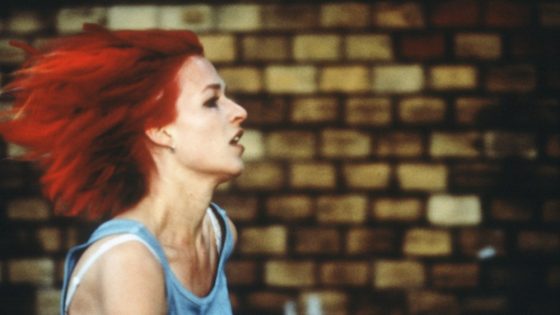Of all the heady-cool, matrix-of-reality, the-digital-future-is-now movies released in 1999, “Run Lola Run” may have been the 1999iest. Sure, “The Matrix” was the sci-fi landmark that bullet-timed audiences into the 21st century. But science-fiction movies have always looked ahead. That’s their job. (Maybe the first true movie of 1999 was “2001: A Space Odyssey.”) “Run Lola Run” was a candy-colored punk Berlin fantasia set in this world, and that was its glory.
The movie is being rereleased, starting Friday, June 7, in a new 4K version to mark the 25th anniversary of its release in America. (It came out in Germany the year before.) And what a difference a quarter of a century makes! The days of our lives now run on digital kinetic energy. Our imaginations hum and click to the mutating magic of technological possibility. When we don’t like reality, we reset it. “Run Lola Run” foresaw all that, incarnating it in a cinematic fable of destiny that felt like a three-part video game that was playing you.
And yet…there’s an innocence, an analog urgency built into the film’s existential pop-art futurism that can make you feel weirdly nostalgic. Lola, played by the indelible Franka Potente, who’s like Lili Taylor with the flaming red hair of a new-wave knockoff of the god Hermes, has just 20 minutes to save her boyfriend, Manni (Moritz Bleibtreu). At 12:00 noon, he has to make a payoff of 100,000 Deutschmarks to his underworld boss. But he left the money in a shopping bag on a subway train, where it was taken by a vagrant. So he’s now at a payphone calling Lola, who failed to meet him at the pick-up spot. How will she save the day?
By running through the streets of Berlin. She’ll run for Manni. She’ll run for her life. She’ll run and run and run and forge her fate with every breathless step. Destiny, and the way we influence it, is the theme of “Run Lola Run,” though that theme is in some ways a spectacular contradiction. You can’t influence…fate. (Fate is what’s going to happen because it’s going to happen.) Yet you can influence outcome, and in doing so maybe you can bend and defeat fate.
What “Run Lola Run” is really about is how in a world unified by the centrifugal force of invisible technology, everything is connected, including the things that we don’t know are connected. If I do this it will shift that, which will change this, which will exert a magnetic influence upon…everything. It’s the butterfly effect (the idea first expressed in Mark Twain’s dawn-of-the-20th-century novel “The Mysterious Stranger”), now heightened to an impeccably timed exactitude that speaks to the deterministic man-machine quality of our lives.
“Run Lola Run” tells three different versions of the same story (they breeze by in something like real time, which is why the film is only 80 minutes long), and the story itself is a scruffy soap opera. Lola runs to the bank where her bourgeois father is an executive, to ask him for 100,000 marks. At that moment, he’s in a fateful encounter of his own (his mistress is asking him to leave his wife, and is about to tell him she’s pregnant). Depending on the split-second timing of everything, what he learns and when he learns it will influence events. So will the precise timing of when Lola runs in front of a car coming out of a garage, or when an ambulance approaches a bunch of people carrying a plate-glass window, or when Manni, giving up hope, takes a gun into a supermarket to hold the place up. Every possibility of action plugs us, thrillingly, into the moment and only that moment. That’s the film’s post-Tarantino dimension.
Tom Tykwer, the writer-director of “Run Lola Run,” was 32 when he made it, and it’s no insult to say that in this movie he treats filmmaking like drugs: as a mood enhancer to snort right into your mind’s eye. “Run Lola Run” was the ultimate feature-length music video to get high on, and maybe it still is. Part of the thrill is that Tykwer made a film whose pulsating interior energy marks a revolutionary break with 100 years of German cinema. (There’s no vestige of Teutonic spirit.) I assumed, when I first saw the film, that Tykwer would go on to have a major career in Hollywood, making technologically advanced blockbusters that coasted along on their playful surface. But “Run Lola Run” turned out to be a one-shot, an adrenalized anomaly. It’s part of the beauty of the film that Tykwer never made another one like it. No one did.
The playful sequence of an animated Lola running down the stairs that kicks off each episode; the racing-camera framing that’s both classical and confectionary; the repetition of events with micro variations; the split screens and high angles; the moments when Lola bumps into a pedestrian and the audience is given a karmic vision (in rapid-fire freeze frames) of how the rest of their life will play out based on that moment; the way the vagrant with the money circles back; the way Lola, playing a roulette wheel, stops a casino cold with her telekinetic scream of force; the bouncing throbbing relentless techno soundtrack (co-written by Tykwer), which is nothing less than the life force of Lola’s heartbeat talking to us (“I don’t believe in trouble, I don’t believe in pain, I don’t believe there’s nothing left but running here again”). All of that was exhilarating 25 years ago, and it’s even more exhilarating now.
The reason for that, I think, is that for all the clockwork futurism, the emotion that drives “Run Lola Run” is a pure relic of the ’90s, and that emotion is optimism. The romance of forging your fate. In the first version of the film’s events, Lola performs well enough but doesn’t succeed. The next two versions echo the tone of the pillow-talk conversations we see her having with Manni in between. When he won’t affirm her love the way she wants and needs, the episode turns out disastrously. When the two connect, anything is possible. “Run Lola Run” came out on the precipice of an age when people felt newly empowered by technology, yet also feared that technology had the potential to steal their souls. The film says: Use the power. Steal your soul back. Don’t just grab your destiny. Run for it.
Source Agencies


